2001 CHRYSLER VOYAGER relay
[x] Cancel search: relayPage 1314 of 4284
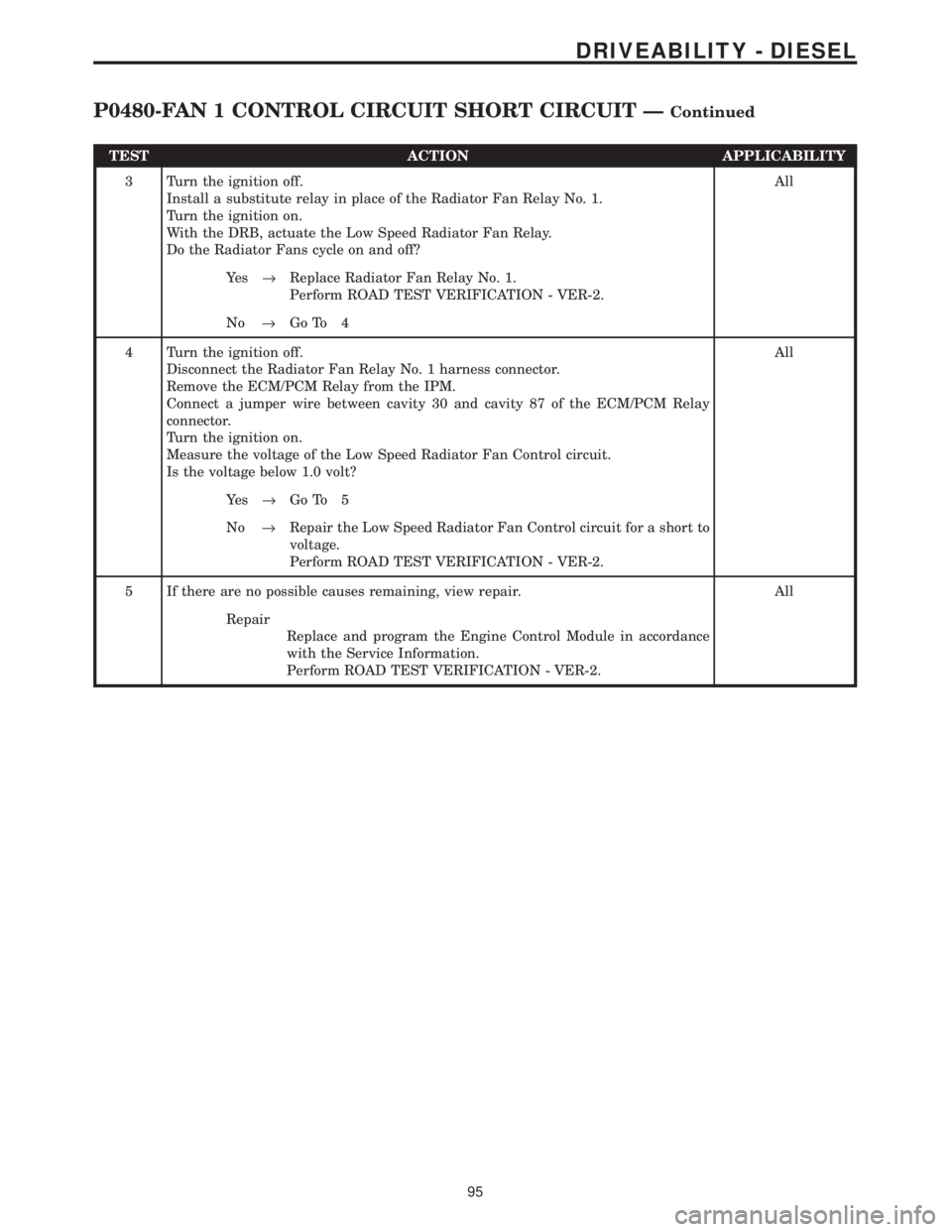
TEST ACTION APPLICABILITY
3 Turn the ignition off.
Install a substitute relay in place of the Radiator Fan Relay No. 1.
Turn the ignition on.
With the DRB, actuate the Low Speed Radiator Fan Relay.
Do the Radiator Fans cycle on and off?All
Ye s®Replace Radiator Fan Relay No. 1.
Perform ROAD TEST VERIFICATION - VER-2.
No®Go To 4
4 Turn the ignition off.
Disconnect the Radiator Fan Relay No. 1 harness connector.
Remove the ECM/PCM Relay from the IPM.
Connect a jumper wire between cavity 30 and cavity 87 of the ECM/PCM Relay
connector.
Turn the ignition on.
Measure the voltage of the Low Speed Radiator Fan Control circuit.
Is the voltage below 1.0 volt?All
Ye s®Go To 5
No®Repair the Low Speed Radiator Fan Control circuit for a short to
voltage.
Perform ROAD TEST VERIFICATION - VER-2.
5 If there are no possible causes remaining, view repair. All
Repair
Replace and program the Engine Control Module in accordance
with the Service Information.
Perform ROAD TEST VERIFICATION - VER-2.
95
DRIVEABILITY - DIESEL
P0480-FAN 1 CONTROL CIRCUIT SHORT CIRCUIT ÐContinued
Page 1315 of 4284
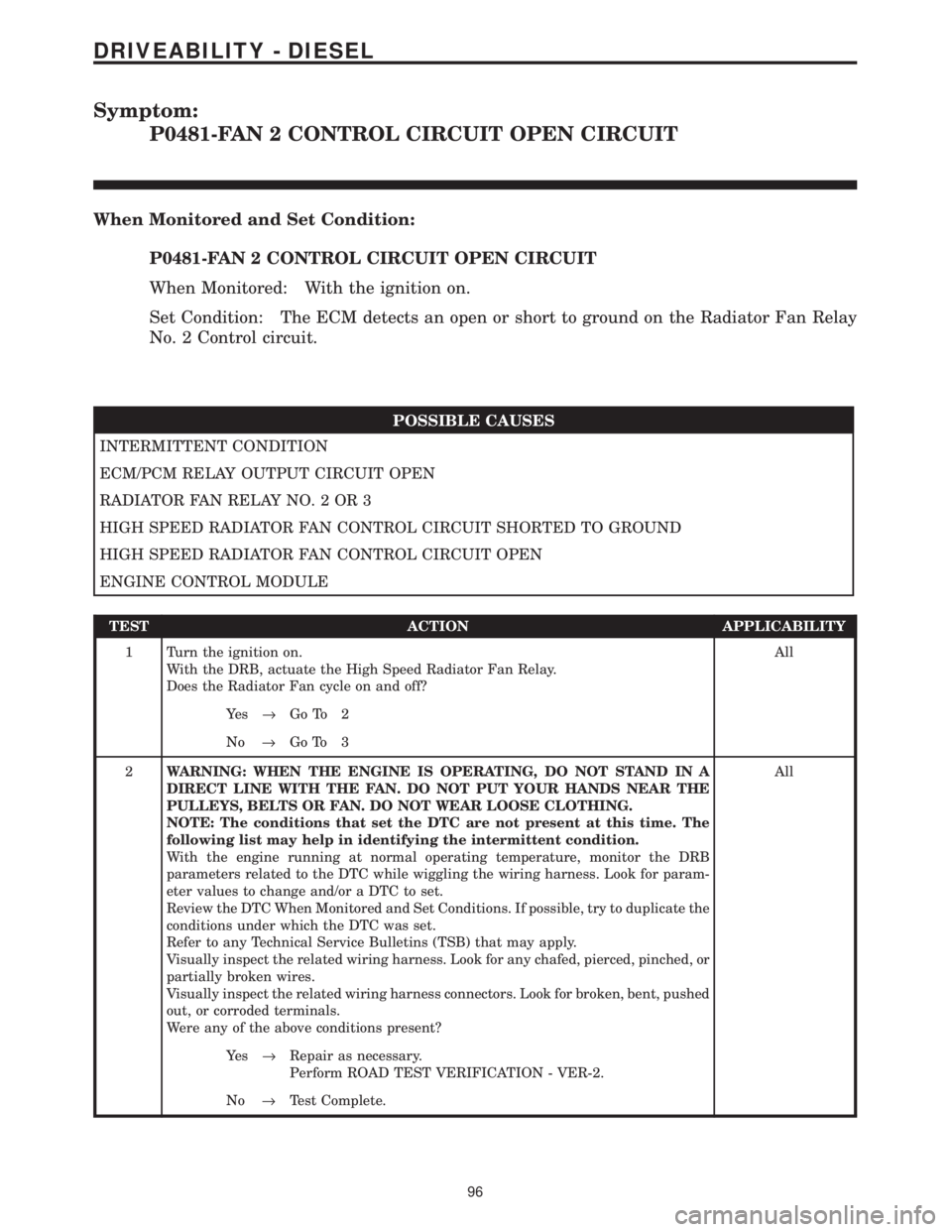
Symptom:
P0481-FAN 2 CONTROL CIRCUIT OPEN CIRCUIT
When Monitored and Set Condition:
P0481-FAN 2 CONTROL CIRCUIT OPEN CIRCUIT
When Monitored: With the ignition on.
Set Condition: The ECM detects an open or short to ground on the Radiator Fan Relay
No. 2 Control circuit.
POSSIBLE CAUSES
INTERMITTENT CONDITION
ECM/PCM RELAY OUTPUT CIRCUIT OPEN
RADIATOR FAN RELAY NO. 2 OR 3
HIGH SPEED RADIATOR FAN CONTROL CIRCUIT SHORTED TO GROUND
HIGH SPEED RADIATOR FAN CONTROL CIRCUIT OPEN
ENGINE CONTROL MODULE
TEST ACTION APPLICABILITY
1 Turn the ignition on.
With the DRB, actuate the High Speed Radiator Fan Relay.
Does the Radiator Fan cycle on and off?All
Ye s®Go To 2
No®Go To 3
2WARNING: WHEN THE ENGINE IS OPERATING, DO NOT STAND IN A
DIRECT LINE WITH THE FAN. DO NOT PUT YOUR HANDS NEAR THE
PULLEYS, BELTS OR FAN. DO NOT WEAR LOOSE CLOTHING.
NOTE: The conditions that set the DTC are not present at this time. The
following list may help in identifying the intermittent condition.
With the engine running at normal operating temperature, monitor the DRB
parameters related to the DTC while wiggling the wiring harness. Look for param-
eter values to change and/or a DTC to set.
Review the DTC When Monitored and Set Conditions. If possible, try to duplicate the
conditions under which the DTC was set.
Refer to any Technical Service Bulletins (TSB) that may apply.
Visually inspect the related wiring harness. Look for any chafed, pierced, pinched, or
partially broken wires.
Visually inspect the related wiring harness connectors. Look for broken, bent, pushed
out, or corroded terminals.
Were any of the above conditions present?All
Ye s®Repair as necessary.
Perform ROAD TEST VERIFICATION - VER-2.
No®Test Complete.
96
DRIVEABILITY - DIESEL
Page 1316 of 4284
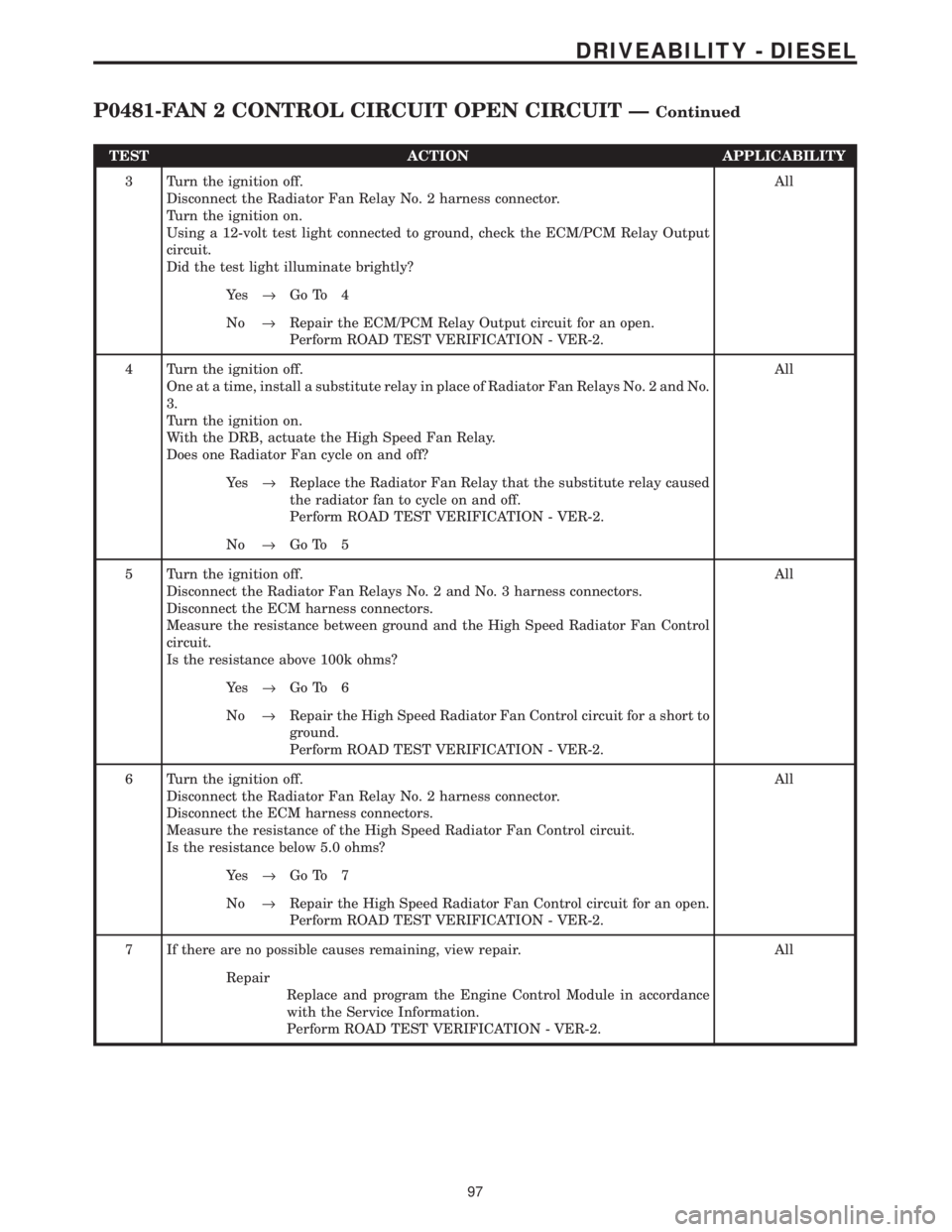
TEST ACTION APPLICABILITY
3 Turn the ignition off.
Disconnect the Radiator Fan Relay No. 2 harness connector.
Turn the ignition on.
Using a 12-volt test light connected to ground, check the ECM/PCM Relay Output
circuit.
Did the test light illuminate brightly?All
Ye s®Go To 4
No®Repair the ECM/PCM Relay Output circuit for an open.
Perform ROAD TEST VERIFICATION - VER-2.
4 Turn the ignition off.
One at a time, install a substitute relay in place of Radiator Fan Relays No. 2 and No.
3.
Turn the ignition on.
With the DRB, actuate the High Speed Fan Relay.
Does one Radiator Fan cycle on and off?All
Ye s®Replace the Radiator Fan Relay that the substitute relay caused
the radiator fan to cycle on and off.
Perform ROAD TEST VERIFICATION - VER-2.
No®Go To 5
5 Turn the ignition off.
Disconnect the Radiator Fan Relays No. 2 and No. 3 harness connectors.
Disconnect the ECM harness connectors.
Measure the resistance between ground and the High Speed Radiator Fan Control
circuit.
Is the resistance above 100k ohms?All
Ye s®Go To 6
No®Repair the High Speed Radiator Fan Control circuit for a short to
ground.
Perform ROAD TEST VERIFICATION - VER-2.
6 Turn the ignition off.
Disconnect the Radiator Fan Relay No. 2 harness connector.
Disconnect the ECM harness connectors.
Measure the resistance of the High Speed Radiator Fan Control circuit.
Is the resistance below 5.0 ohms?All
Ye s®Go To 7
No®Repair the High Speed Radiator Fan Control circuit for an open.
Perform ROAD TEST VERIFICATION - VER-2.
7 If there are no possible causes remaining, view repair. All
Repair
Replace and program the Engine Control Module in accordance
with the Service Information.
Perform ROAD TEST VERIFICATION - VER-2.
97
DRIVEABILITY - DIESEL
P0481-FAN 2 CONTROL CIRCUIT OPEN CIRCUIT ÐContinued
Page 1317 of 4284
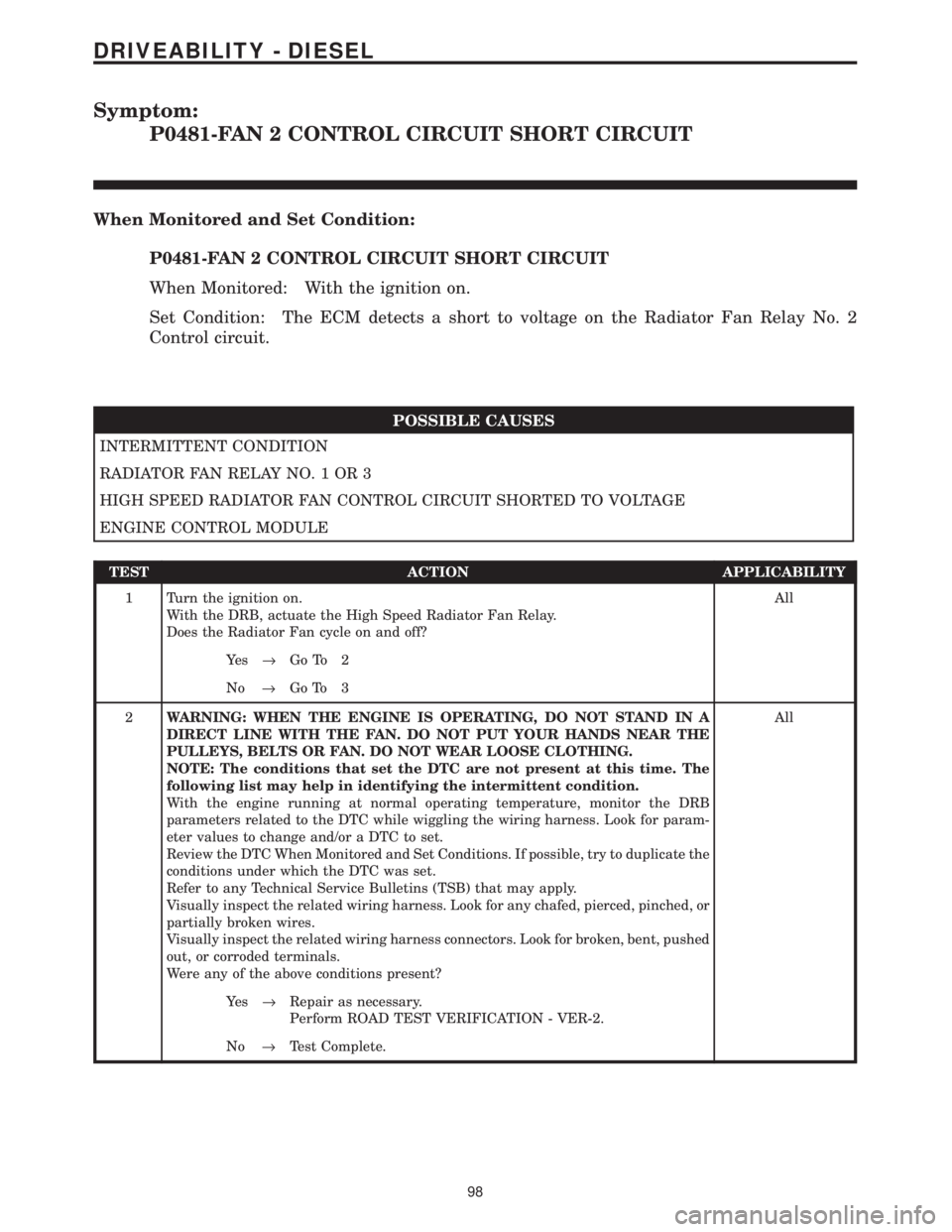
Symptom:
P0481-FAN 2 CONTROL CIRCUIT SHORT CIRCUIT
When Monitored and Set Condition:
P0481-FAN 2 CONTROL CIRCUIT SHORT CIRCUIT
When Monitored: With the ignition on.
Set Condition: The ECM detects a short to voltage on the Radiator Fan Relay No. 2
Control circuit.
POSSIBLE CAUSES
INTERMITTENT CONDITION
RADIATOR FAN RELAY NO. 1 OR 3
HIGH SPEED RADIATOR FAN CONTROL CIRCUIT SHORTED TO VOLTAGE
ENGINE CONTROL MODULE
TEST ACTION APPLICABILITY
1 Turn the ignition on.
With the DRB, actuate the High Speed Radiator Fan Relay.
Does the Radiator Fan cycle on and off?All
Ye s®Go To 2
No®Go To 3
2WARNING: WHEN THE ENGINE IS OPERATING, DO NOT STAND IN A
DIRECT LINE WITH THE FAN. DO NOT PUT YOUR HANDS NEAR THE
PULLEYS, BELTS OR FAN. DO NOT WEAR LOOSE CLOTHING.
NOTE: The conditions that set the DTC are not present at this time. The
following list may help in identifying the intermittent condition.
With the engine running at normal operating temperature, monitor the DRB
parameters related to the DTC while wiggling the wiring harness. Look for param-
eter values to change and/or a DTC to set.
Review the DTC When Monitored and Set Conditions. If possible, try to duplicate the
conditions under which the DTC was set.
Refer to any Technical Service Bulletins (TSB) that may apply.
Visually inspect the related wiring harness. Look for any chafed, pierced, pinched, or
partially broken wires.
Visually inspect the related wiring harness connectors. Look for broken, bent, pushed
out, or corroded terminals.
Were any of the above conditions present?All
Ye s®Repair as necessary.
Perform ROAD TEST VERIFICATION - VER-2.
No®Test Complete.
98
DRIVEABILITY - DIESEL
Page 1318 of 4284
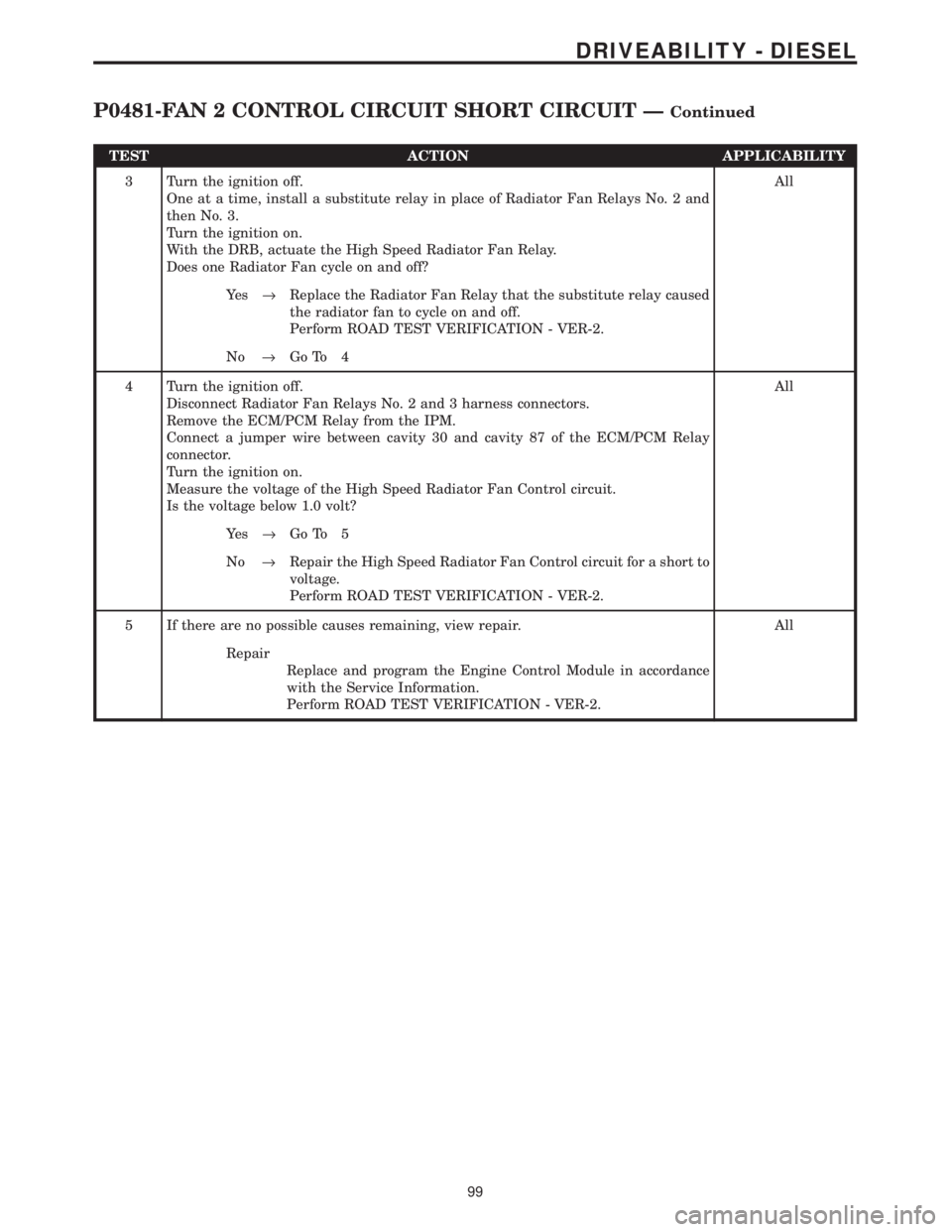
TEST ACTION APPLICABILITY
3 Turn the ignition off.
One at a time, install a substitute relay in place of Radiator Fan Relays No. 2 and
then No. 3.
Turn the ignition on.
With the DRB, actuate the High Speed Radiator Fan Relay.
Does one Radiator Fan cycle on and off?All
Ye s®Replace the Radiator Fan Relay that the substitute relay caused
the radiator fan to cycle on and off.
Perform ROAD TEST VERIFICATION - VER-2.
No®Go To 4
4 Turn the ignition off.
Disconnect Radiator Fan Relays No. 2 and 3 harness connectors.
Remove the ECM/PCM Relay from the IPM.
Connect a jumper wire between cavity 30 and cavity 87 of the ECM/PCM Relay
connector.
Turn the ignition on.
Measure the voltage of the High Speed Radiator Fan Control circuit.
Is the voltage below 1.0 volt?All
Ye s®Go To 5
No®Repair the High Speed Radiator Fan Control circuit for a short to
voltage.
Perform ROAD TEST VERIFICATION - VER-2.
5 If there are no possible causes remaining, view repair. All
Repair
Replace and program the Engine Control Module in accordance
with the Service Information.
Perform ROAD TEST VERIFICATION - VER-2.
99
DRIVEABILITY - DIESEL
P0481-FAN 2 CONTROL CIRCUIT SHORT CIRCUIT ÐContinued
Page 1321 of 4284
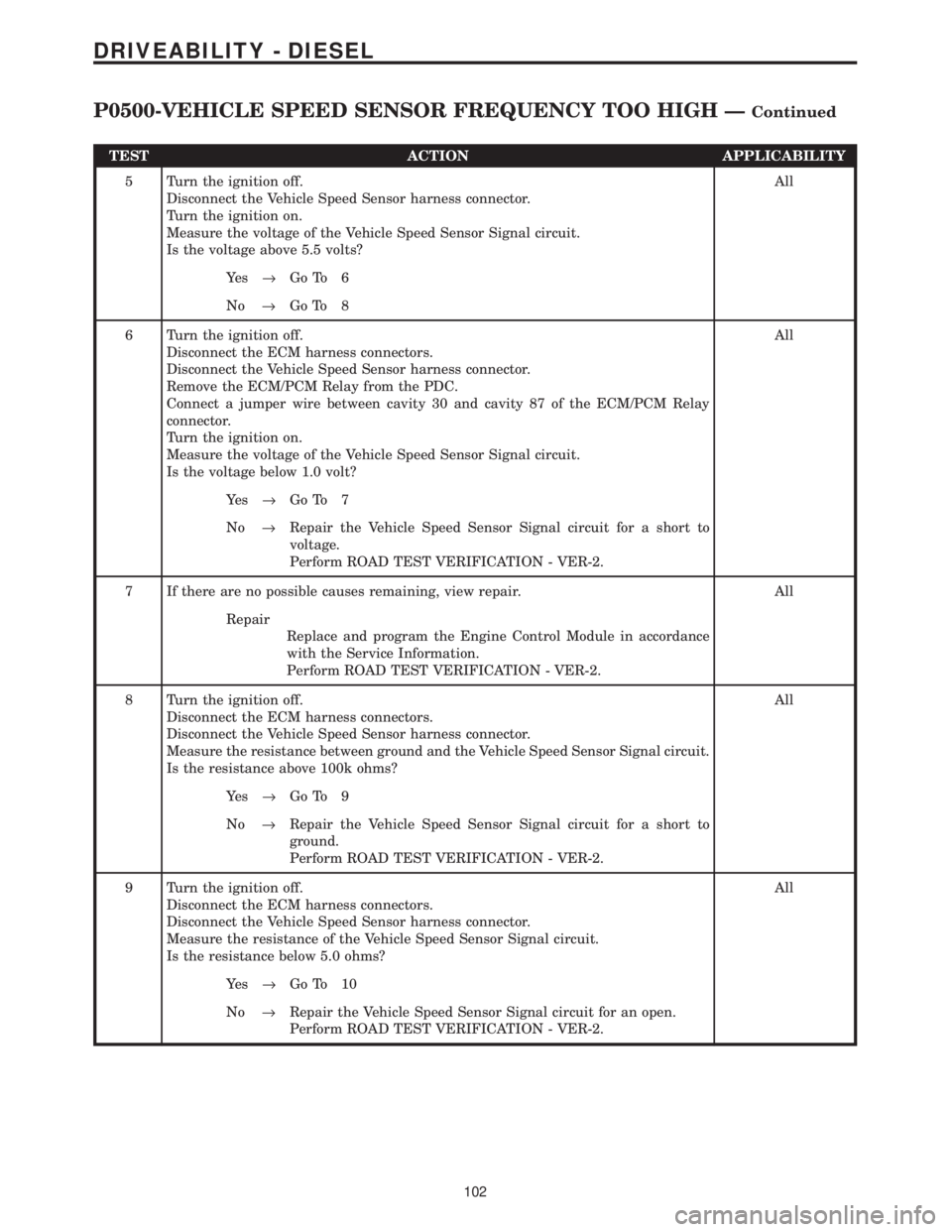
TEST ACTION APPLICABILITY
5 Turn the ignition off.
Disconnect the Vehicle Speed Sensor harness connector.
Turn the ignition on.
Measure the voltage of the Vehicle Speed Sensor Signal circuit.
Is the voltage above 5.5 volts?All
Ye s®Go To 6
No®Go To 8
6 Turn the ignition off.
Disconnect the ECM harness connectors.
Disconnect the Vehicle Speed Sensor harness connector.
Remove the ECM/PCM Relay from the PDC.
Connect a jumper wire between cavity 30 and cavity 87 of the ECM/PCM Relay
connector.
Turn the ignition on.
Measure the voltage of the Vehicle Speed Sensor Signal circuit.
Is the voltage below 1.0 volt?All
Ye s®Go To 7
No®Repair the Vehicle Speed Sensor Signal circuit for a short to
voltage.
Perform ROAD TEST VERIFICATION - VER-2.
7 If there are no possible causes remaining, view repair. All
Repair
Replace and program the Engine Control Module in accordance
with the Service Information.
Perform ROAD TEST VERIFICATION - VER-2.
8 Turn the ignition off.
Disconnect the ECM harness connectors.
Disconnect the Vehicle Speed Sensor harness connector.
Measure the resistance between ground and the Vehicle Speed Sensor Signal circuit.
Is the resistance above 100k ohms?All
Ye s®Go To 9
No®Repair the Vehicle Speed Sensor Signal circuit for a short to
ground.
Perform ROAD TEST VERIFICATION - VER-2.
9 Turn the ignition off.
Disconnect the ECM harness connectors.
Disconnect the Vehicle Speed Sensor harness connector.
Measure the resistance of the Vehicle Speed Sensor Signal circuit.
Is the resistance below 5.0 ohms?All
Ye s®Go To 10
No®Repair the Vehicle Speed Sensor Signal circuit for an open.
Perform ROAD TEST VERIFICATION - VER-2.
102
DRIVEABILITY - DIESEL
P0500-VEHICLE SPEED SENSOR FREQUENCY TOO HIGH ÐContinued
Page 1327 of 4284
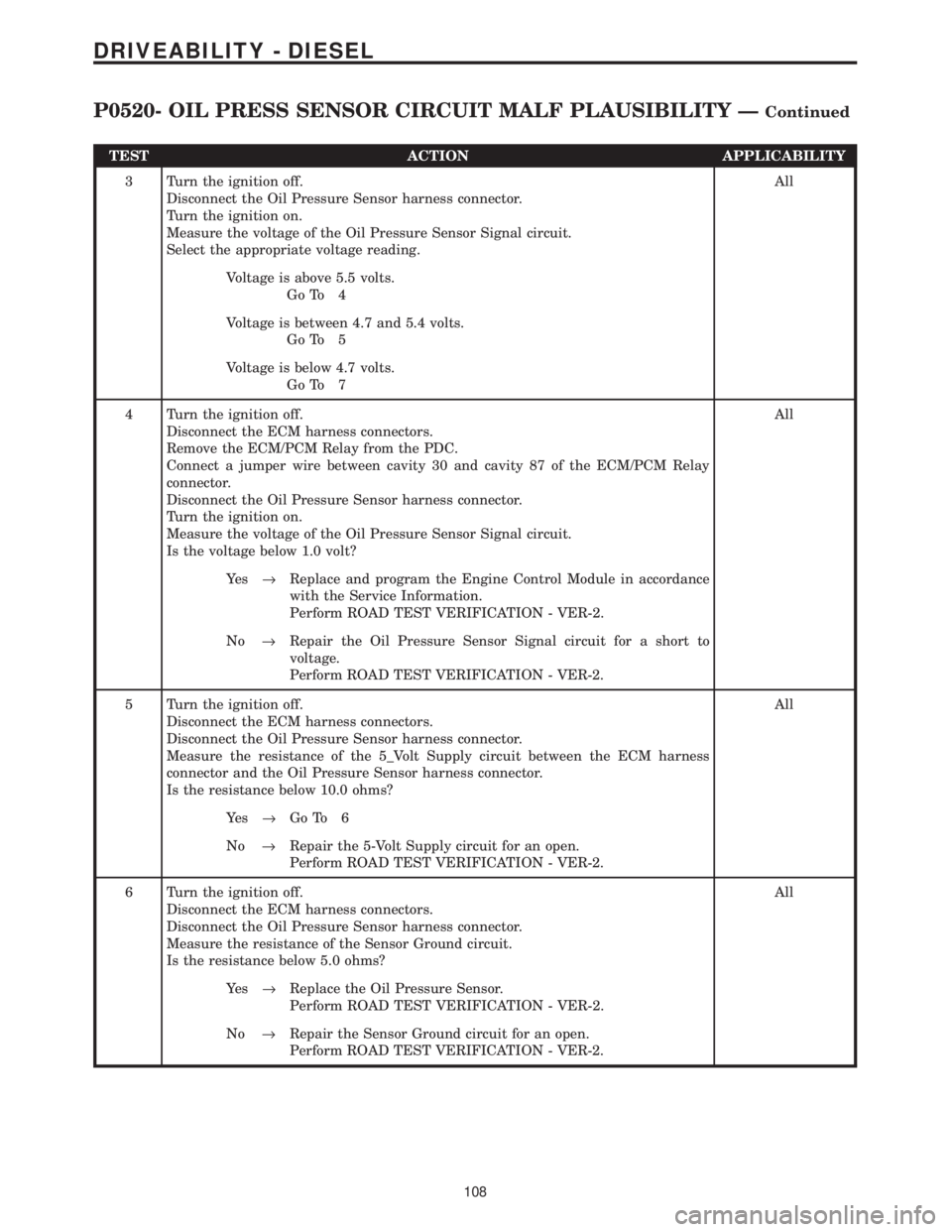
TEST ACTION APPLICABILITY
3 Turn the ignition off.
Disconnect the Oil Pressure Sensor harness connector.
Turn the ignition on.
Measure the voltage of the Oil Pressure Sensor Signal circuit.
Select the appropriate voltage reading.All
Voltage is above 5.5 volts.
Go To 4
Voltage is between 4.7 and 5.4 volts.
Go To 5
Voltage is below 4.7 volts.
Go To 7
4 Turn the ignition off.
Disconnect the ECM harness connectors.
Remove the ECM/PCM Relay from the PDC.
Connect a jumper wire between cavity 30 and cavity 87 of the ECM/PCM Relay
connector.
Disconnect the Oil Pressure Sensor harness connector.
Turn the ignition on.
Measure the voltage of the Oil Pressure Sensor Signal circuit.
Is the voltage below 1.0 volt?All
Ye s®Replace and program the Engine Control Module in accordance
with the Service Information.
Perform ROAD TEST VERIFICATION - VER-2.
No®Repair the Oil Pressure Sensor Signal circuit for a short to
voltage.
Perform ROAD TEST VERIFICATION - VER-2.
5 Turn the ignition off.
Disconnect the ECM harness connectors.
Disconnect the Oil Pressure Sensor harness connector.
Measure the resistance of the 5_Volt Supply circuit between the ECM harness
connector and the Oil Pressure Sensor harness connector.
Is the resistance below 10.0 ohms?All
Ye s®Go To 6
No®Repair the 5-Volt Supply circuit for an open.
Perform ROAD TEST VERIFICATION - VER-2.
6 Turn the ignition off.
Disconnect the ECM harness connectors.
Disconnect the Oil Pressure Sensor harness connector.
Measure the resistance of the Sensor Ground circuit.
Is the resistance below 5.0 ohms?All
Ye s®Replace the Oil Pressure Sensor.
Perform ROAD TEST VERIFICATION - VER-2.
No®Repair the Sensor Ground circuit for an open.
Perform ROAD TEST VERIFICATION - VER-2.
108
DRIVEABILITY - DIESEL
P0520- OIL PRESS SENSOR CIRCUIT MALF PLAUSIBILITY ÐContinued
Page 1329 of 4284
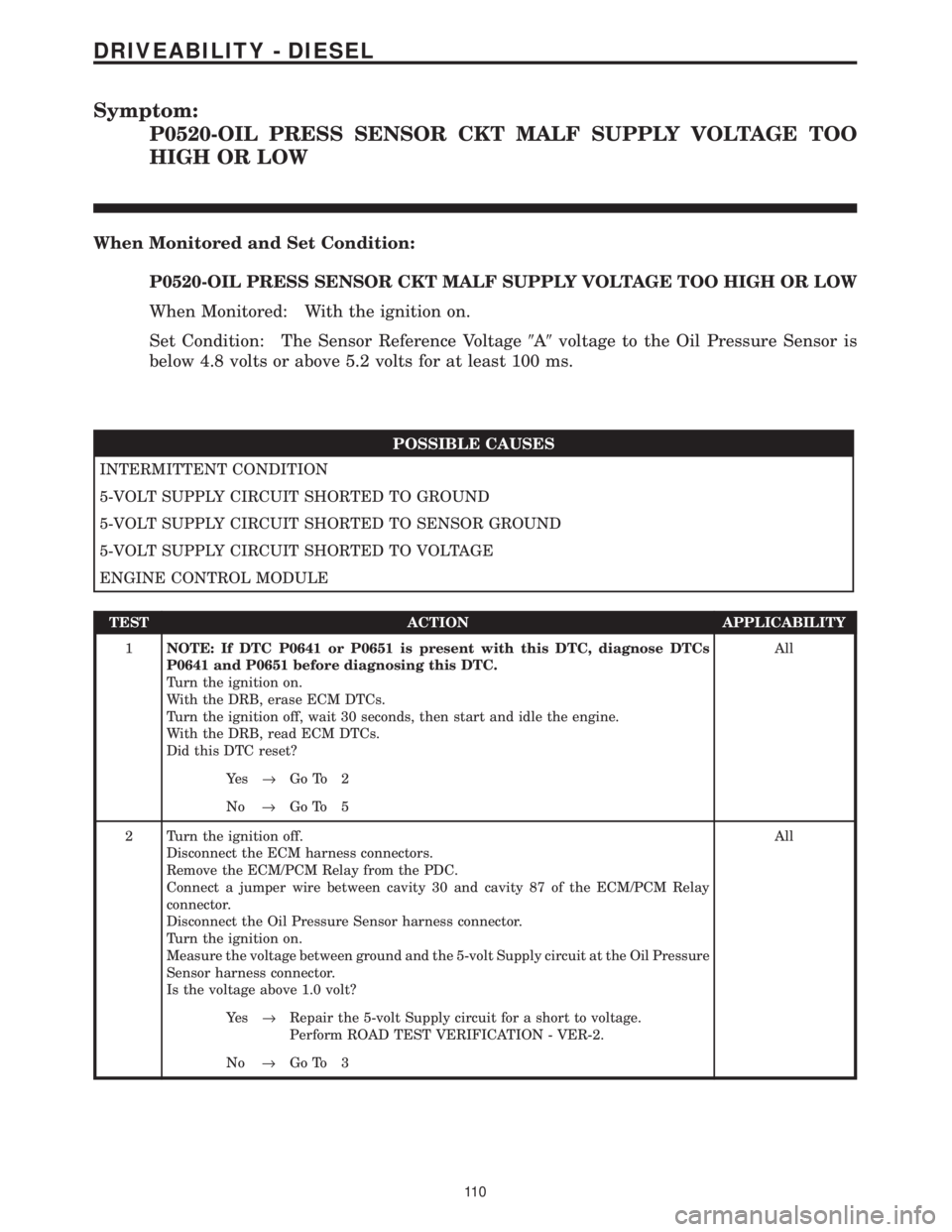
Symptom:
P0520-OIL PRESS SENSOR CKT MALF SUPPLY VOLTAGE TOO
HIGH OR LOW
When Monitored and Set Condition:
P0520-OIL PRESS SENSOR CKT MALF SUPPLY VOLTAGE TOO HIGH OR LOW
When Monitored: With the ignition on.
Set Condition: The Sensor Reference Voltage9A9voltage to the Oil Pressure Sensor is
below 4.8 volts or above 5.2 volts for at least 100 ms.
POSSIBLE CAUSES
INTERMITTENT CONDITION
5-VOLT SUPPLY CIRCUIT SHORTED TO GROUND
5-VOLT SUPPLY CIRCUIT SHORTED TO SENSOR GROUND
5-VOLT SUPPLY CIRCUIT SHORTED TO VOLTAGE
ENGINE CONTROL MODULE
TEST ACTION APPLICABILITY
1NOTE: If DTC P0641 or P0651 is present with this DTC, diagnose DTCs
P0641 and P0651 before diagnosing this DTC.
Turn the ignition on.
With the DRB, erase ECM DTCs.
Turn the ignition off, wait 30 seconds, then start and idle the engine.
With the DRB, read ECM DTCs.
Did this DTC reset?All
Ye s®Go To 2
No®Go To 5
2 Turn the ignition off.
Disconnect the ECM harness connectors.
Remove the ECM/PCM Relay from the PDC.
Connect a jumper wire between cavity 30 and cavity 87 of the ECM/PCM Relay
connector.
Disconnect the Oil Pressure Sensor harness connector.
Turn the ignition on.
Measure the voltage between ground and the 5-volt Supply circuit at the Oil Pressure
Sensor harness connector.
Is the voltage above 1.0 volt?All
Ye s®Repair the 5-volt Supply circuit for a short to voltage.
Perform ROAD TEST VERIFICATION - VER-2.
No®Go To 3
11 0
DRIVEABILITY - DIESEL